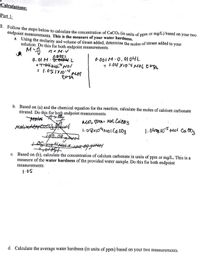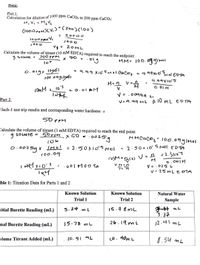
Chemistry
10th Edition
ISBN: 9781305957404
Author: Steven S. Zumdahl, Susan A. Zumdahl, Donald J. DeCoste
Publisher: Cengage Learning
expand_more
expand_more
format_list_bulleted
Question
a-c

Transcribed Image Text:Calculations:
Part 1:
1. Follow the steps below to calculate the concentration of CaCO3 (in units of ppm or mg/L.) based on your two
endpoint measurements. This is the measure of your water hardness.
a. Using the molarity and volume of titrant added, determine the moles of titrant added to your
solution. Do this for both endpoint measurements.
0.0 051.
0. ol M. O10H L
0-001M.0. 01 04L
- 1.04 X10"S MOL EDTA
: 1.051X10-4
EPTÁ
b. Based on (a) and the chemical equation for the reaction, calculate the moles of calcium carbonate
titrated. Do this for both endpoint measurements.
Motes
mor EDIA. Mel Calco3
|.040x.105 Mol ca ety
c. Based on (b), calculate the concentration of calcium carbonate in units of ppm or mg/L. This is a
measure of the water hardness of the provided water sample. Do this for both endpoint
measurements.
1-os
d. Calculate the average water hardness (in units of ppm) based on your two measurements.

Transcribed Image Text:Data:
Part I.
Calculation for dilution of 1000 Ppm CaCO, to 200 ppm CaCO:
M, V, = Mz Vz
Co00r.m)CV) (200)
2o000
J000
V4- 20mL
Calculate the volume of titrant (10 mM EDTA) required to reach the endpoint:
9 somte .
200 PPM
• olg
MM- 100.0ggiml
0.01gy IM6!
100.0agly61
9.99 X1ó 5mol Caco,
q.99x105
MOIEDTA
9.99VI6'S
M=n V
0.01M
1ONM 103
2 0.0l AM
V = . 00999L
V-n.99 ML 10 mL EDTA
Part 2.
Hach-1 test trip results and corresponding water hardness: --
50ppm
Calculate the volume of titrant (1 mM EDTA) required to reach the end point:
g soute = S0ppmx50
MMCACO3" 100.09glmol
106
0.0025g x IMo = 2.50 x1osMol
100.09
- 2.50x 10 S MOI EDTA
V=n :2.5XIos
0. 001M
V = .025 L
v= 25 ML EOTA
: .001 MED TA
ble 1: Titration Data for Parts 1 and 2
Known Solution
Known Solution
Natural Water
Trial 1
Trial 2
Sample
nitial Burette Reading (mL)
5.24 mL
15.4 6 mL
3.87
12.니1 mL
inal Burette Reading (mL)
15.78 mL
26.19 ml
Lo. 40m L
8.54 mu
olume Titrant Added (mL)
to. 51 ML
Expert Solution
This question has been solved!
Explore an expertly crafted, step-by-step solution for a thorough understanding of key concepts.
This is a popular solution
Trending nowThis is a popular solution!
Step by stepSolved in 4 steps

Knowledge Booster
Learn more about
Need a deep-dive on the concept behind this application? Look no further. Learn more about this topic, chemistry and related others by exploring similar questions and additional content below.Similar questions
- Y) NaoH NaOH 2) $ C#z ě H + A) KOH OH CHz' c#3 B) KOH OH Na OH + CHs CcHte)a JuaOH O=)arrow_forwardConsider the reaction between aqueous solutions of ammonia and sodium cyanide. Select the products of the net ionic equation and whether products or reactants are favoured in the reaction. HCN(aq) NH4*(aq) NH2 (aq) OH (aq) | H20(?)arrow_forwardWhat is the classification of the compound shown below? ÇH,OH O: H-C-OH CH,OH A) L B) D C) A sugar this small is not classified as L or D.arrow_forward
- Ch. 16 - Car xylic AcluS 1. Name the following carboxylic acids. Use both IUPAC and common names. b) CHs- cy-E-on c) CHz-CHz-cooH a) --OH d) CH-CHt ) CHy-CH と-OH GOH CH-CH-CHy Ho-ビ-CH - と。 f) CH-CH-C-Cty CH2 for e Longth k) Ho- -CH l CH lee Ho-C-C4,-CH-C-oHarrow_forwardgive a 5 letter answer in orderarrow_forwardComplete the following reaction:arrow_forward
arrow_back_ios
arrow_forward_ios
Recommended textbooks for you
 ChemistryChemistryISBN:9781305957404Author:Steven S. Zumdahl, Susan A. Zumdahl, Donald J. DeCostePublisher:Cengage Learning
ChemistryChemistryISBN:9781305957404Author:Steven S. Zumdahl, Susan A. Zumdahl, Donald J. DeCostePublisher:Cengage Learning ChemistryChemistryISBN:9781259911156Author:Raymond Chang Dr., Jason Overby ProfessorPublisher:McGraw-Hill Education
ChemistryChemistryISBN:9781259911156Author:Raymond Chang Dr., Jason Overby ProfessorPublisher:McGraw-Hill Education Principles of Instrumental AnalysisChemistryISBN:9781305577213Author:Douglas A. Skoog, F. James Holler, Stanley R. CrouchPublisher:Cengage Learning
Principles of Instrumental AnalysisChemistryISBN:9781305577213Author:Douglas A. Skoog, F. James Holler, Stanley R. CrouchPublisher:Cengage Learning Organic ChemistryChemistryISBN:9780078021558Author:Janice Gorzynski Smith Dr.Publisher:McGraw-Hill Education
Organic ChemistryChemistryISBN:9780078021558Author:Janice Gorzynski Smith Dr.Publisher:McGraw-Hill Education Chemistry: Principles and ReactionsChemistryISBN:9781305079373Author:William L. Masterton, Cecile N. HurleyPublisher:Cengage Learning
Chemistry: Principles and ReactionsChemistryISBN:9781305079373Author:William L. Masterton, Cecile N. HurleyPublisher:Cengage Learning Elementary Principles of Chemical Processes, Bind...ChemistryISBN:9781118431221Author:Richard M. Felder, Ronald W. Rousseau, Lisa G. BullardPublisher:WILEY
Elementary Principles of Chemical Processes, Bind...ChemistryISBN:9781118431221Author:Richard M. Felder, Ronald W. Rousseau, Lisa G. BullardPublisher:WILEY

Chemistry
Chemistry
ISBN:9781305957404
Author:Steven S. Zumdahl, Susan A. Zumdahl, Donald J. DeCoste
Publisher:Cengage Learning

Chemistry
Chemistry
ISBN:9781259911156
Author:Raymond Chang Dr., Jason Overby Professor
Publisher:McGraw-Hill Education

Principles of Instrumental Analysis
Chemistry
ISBN:9781305577213
Author:Douglas A. Skoog, F. James Holler, Stanley R. Crouch
Publisher:Cengage Learning

Organic Chemistry
Chemistry
ISBN:9780078021558
Author:Janice Gorzynski Smith Dr.
Publisher:McGraw-Hill Education

Chemistry: Principles and Reactions
Chemistry
ISBN:9781305079373
Author:William L. Masterton, Cecile N. Hurley
Publisher:Cengage Learning

Elementary Principles of Chemical Processes, Bind...
Chemistry
ISBN:9781118431221
Author:Richard M. Felder, Ronald W. Rousseau, Lisa G. Bullard
Publisher:WILEY